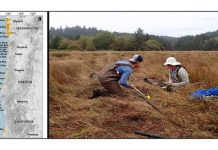Robert Grant, Professor at the University of Alberta looks at predicting the effects of climate change on terrestrial ecosystems with a mathematical model…
Changes in climate are causing widespread impacts on hydrology and productivity of terrestrial ecosystems and will continue to do so in the future. Consequent changes in greenhouse gas (GHG) exchange with the atmosphere may hasten future climate change. Process-based simulation models are therefore needed to anticipate changes in terrestrial productivity and GHG exchange under changing climate and disturbances, both natural and anthropogenic.
The research program described here meets this need by developing and testing a mathematical model (ecosys) of natural and managed ecosystems. This model is distinguished from other such models by the comprehensiveness and detail of its processes. The model integrates basic findings from biometeorology, plant biology, soil biology, soil physics and soil chemistry into the study of complex ecosystem behaviour under changing weather and disturbance.
This model has been used to anticipate ecosystem response to hypothesised changes in environmental conditions. Projections by ecosys of climate change impacts on an arctic landscape (Grant et al., 2015a,b), indicated that increasing heat advection from increasing precipitation and overland flow would accelerate permafrost degradation, active layer deepening and methane emission. Consequently climate change impacts in permafrost-affected regions would be greater than those projected in most current studies in which heat advection is not considered.
Model use in climate change studies requires well-constrained testing of model response functions to changes in temperature and atmospheric CO2 concentration (Ca) under diverse site conditions. Such testing has been conducted as part of several interdisciplinary research projects, including the Fluxnet-Canada Research Network (FCRN), Canada Carbon Project (CCP), the North America Carbon Project (NACP), the Climate Impacts on Canadian Arctic Tundra (CICAT), Arctic Development and Adaptation to Permafrost in Transition (ADAPT), NitroEurope and the Next Generation Ecosystem Experiments (NGEE), and documented in ~100 peer-reviewed publications in a wide range of scientific journals. A few examples follow:
The response of ecosys to elevated Ca was tested against measurements of NPP, wood growth, C and N stocks and N cycling at three forest Free Air CO2 Enrichment (FACE) sites with contrasting climates and plant functional types (Grant, 2013). This study demonstrated that the priming of soil N cycling is vital to the accurate modelling of ecosystem response to rising Ca, yet is currently overlooked in most ecosystem models.
The modelled responses of wheat growth, yield and yield components to increases in canopy temperature (Tc) was tested against measurements recorded under controlled heating over a range of temperatures (Grant et al., 2011). These responses clearly indicated gains in growth and yield with warming at lower Tc and losses at higher. Such testing is vital to confidence in model projections of climate warming effects on plant growth.
Modelled responses of C and N stocks of soil and trees to artificial soil warming were tested against measurements recorded in the Harvard Forest (Grant, 2014). The initial decline in ecosystem C stocks with heating was modelled as a disturbance response of soil C and N cycling to sudden heating. This response was not simulated with gradual climate warming which caused gains in tree C stocks consistent with observations in warmer vs. cooler climates. These different responses to warming indicated risks in inferring long term responses directly from short-term experiments.
The impacts of changing hydrology on wetlands have not been well represented in ecosystem models. To improve this representation, algorithms have been implemented and tested in ecosys to model constraints on C cycling imposed by O2 transport (Grant et al., 2012). These algorithms were used to model hydrologic effects on net CO2 exchange in drained vs. undrained tropical peatlands (Mezbahuddin et al., 2014; 2015), in an ombrotrophic bog (Dimitrov et al., 2010a,b,c; 2011), along a boreal forest – fen ecotone (Dimitrov et al., 2014a,b) and in an arctic landscape (Grant et al., 2015). These algorithms are vital to modelling climate change effects on C and nutrient cycling, GHG exchange and productivity of wetland ecosystems.
The ability of model processes to explain variation in net CO2 exchange of diverse ecosystems has been tested at diurnal to decadal time scales across a wide variety of climates and disturbances. Model processes explained sharp transitions from C sink to source widely measured in coniferous forests (Grant et al., 2009a,b) and arctic tundra (Grant et al., 2015) caused by warming above 20 °C. Such non-linear transitions are likely to become more frequent as climate change progresses, and so need to be represented in ecosystem models.
In several international model intercomparisons conducted in the NACP, ecosys was consistently ranked as one of the best performers among comprehensive, fully prognostic models for which results were submitted across a wide range of sites (Keenan et al., 2012; Richardson et al., 2012; Schaefer et al., 2012; Schwalm et al., 2010, Sulman et al., 2012).
Ecosys has been applied at continental scales through participation in the NACP Multi-Scale Terrestrial Model Intercomparison Project (MsTMIP) in which ecosys was run at 0.25°C resolution over North America (Mekonnen et al., 2016a,b). Outputs from this run were tested at a continental scale against remotely sensed products such as MODIS NDVI and GPP, and against NEP inferred from inversion and inventory products such as Carbon Tracker and SOCCR reports. These outputs have provided process based explanations for key impacts of changing climates on regional hydrology (e.g. impacts of arctic warming on ALD in Fig. 1 and of Midwestern droughts on ecosystem productivity in Fig. 2). Further large-scale applications of ecosys will be realised through coupling with the Community Earth System Model (CESM) currently underway at the Lawrence Berkeley National Laboratory of the USDoE.
References
- Dimitrov, D.D. et al. 2014. Ecol. Model. 274: 57-70
- Dimitrov, D.D. et al. 2014. Ecol. Model. 291: 96–108
- Dimitrov, D.D. et al. 2011. JGR Biogeosci. 116, G04010
- Dimitrov, D.D. et al. 2010. JGR Biogeosci. 115, G04043
- Dimitrov, D.D. et al. 2010. SSSAJ. 74:680-694
- Dimitrov, D.D. et al. 2014. SSSAJ. 74 1406-1425
- Grant, R.F. et al. 2012. Biogeosci. 9:4215–4231
- Grant et al., 2015. JGR Biogeosci. 120: 1366–1387
- Grant, 2015. JGR Biogeosci..120: 1388–1406
- Grant, R.F. 2013. Biogeosci. 10: 7703-7721
- Grant, R.F. 2014. Ecol. Model. 288: 38-46
- Grant, R.F. et al., 2011. Agron. J. 103:1742-1754
- Grant, R.F. et al. 2009a. Agric. For. Meteorol. 149:2022–2039
- Grant, R.F. et al. 2009b. Tree Physiol. 29:1-17
- Grant, R.F. et al. 2009c. Ecol. Mono. 79(3): 445–463
- Grant, R.F. et al. 2010. Tellus B. 62B: 475-496
- Grant, R.F. et al. 2011. JGR Biogeosci. 116, G01031,doi:10.1029/2010JG001555
- Grant, R.F. et al. 2012. Agric. For. Meteorol. 152: 189– 200
- Grant, R.F. et al. 2006. Agric. For. Meteorol. 140: 152-170
- Keenan TF et al. 2012. Global Change Biol., 18:1971–1987
- Mekonnen, Z.A. et al. 2016. Agric. For. Meteorol. 218-219: 50-64
- Mekonnen, Z.A. et al. 2016. Ecol. Model. 320: 241-257
- Mezbahuddin, M. et al. 2014. Biogeosci. 11: 577-599
- Mezbahuddin, M. et al. 2015. JGR Biogeosci. 120: 2132–2157
- Richardson A.D. et al.. 2012. Global Change Biol. 18, 566–584
- Schaefer K et al. 2012. JGR Biogeosci. 117, G03010
- Schwalm CR et al., 2010. JGR Biogeosci 115, G00H05
- Sulman BN et al. 2012 JGR Biogeosci. 117, G01031
Robert Grant
Professor
Department of Renewable Resources, University of Alberta
Tel: 011 780 492 6609
rgrant@ualberta.ca
http://www.rr.ualberta.ca/StaffProfiles/AcademicStaff/Grant.aspx
Please note: this is a commercial profile













